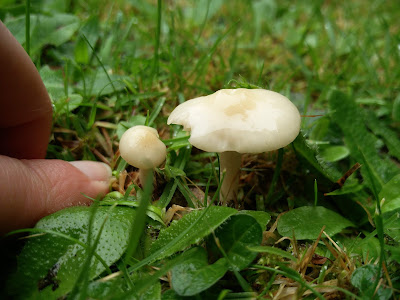I stopped off at a meadow too, which had been reported to be good for waxcaps some years ago. Here I just found a patch of Yellow Fieldcap Bolbitius titubans.
Nice looking mushrooms when you catch them like this, but a sign of nutrient-rich soil which won't be good for waxcaps. Not what I was looking for.
The first churchyard I stopped at looked rather overgrown. Along one edge I found a fine troop of mushrooms.
One of those Gymnopus species. I found it in leaflitter from the nearby shrubs which were encroaching on the churchyard. Not what I was looking for.
The next site – Westmeston churchyard – looked more promising. One area was kept deliberately long, but most of the churchyard looked like it was regularly mown short.
I thought perhaps I'd spied a white waxcap in the grass.
But it wasn't a waxcap.
It was quite a non-descript thing with its pinkish-beige cap, matching stem and white gills.
But wait, it's not just a washed out Pink Domecap Rugosomyces carnea, is it? Whatever it was, it wasn't what I was looking for.
Nearby, well-camouflaged amongst the autumn leaves, I found some brown mushrooms. I could tell straight away these weren't what I was looking for.
Still don't know what these are. But top marks for autumn colour.
This was shortly followed by a Deceiver Laccaria laccata. Unless I have been deceived?
No one's ever looking for these.
Then a funnel of some kind...
... with a rather floury-looking surface. I thought I could detect a not-unpleasant, mealy smell.
Based on not-much-more than a quick flick through 'Fungi of Temperate Europe', I'm liking it for Mealy Frosted Funnel Clitocybe ditopa. But I'd better check its spores.
My last find at Westmeston were some rather waxy-looking white mushrooms.
But they weren't waxcaps either. I'm thinking they're possibly the same as the first mushroom I found at Westmeston. But I'd better take a look at the spores.
Next stop was St Margaret's at Ditchling.
This was another well-kept churchyard, kept rather shorter on the southern side and around the church.
In the mossy sward on the northern side, I found a purplish mycenoid thing.
Lilac Bonnet Mycena pura? I was reasonably convinced I was getting a radish-y smell from it.
In the flatter area of the churchyard, on the northern side, I came across a large fairy ring, 8-10 metres across.
Fruit bodies the size of side plates.
Funnels of some kind...
... but they were going a bit manky and I didn't feel like investigating further. They weren't what I was looking for.
On the way home, I stopped off at the church in Keymer.
Over the wall, I spotted a few tiny fingers of White Spindles Clavaria fragilis poking up through the sward. Not what I was looking for, but a CHEG fungus at least!
I'd completed almost a whole circuit of the churchyard by the time I found this. I think it's Meadow Coral Clavulinopsis corniculata.
Again, not what I was looking for! But a nice fungus to end the day on.
For the record
Date: 29/09/2019


















































